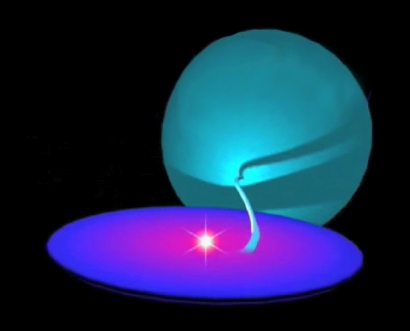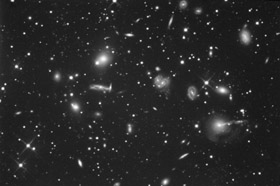Hercules

Figure 1. The constellation Hercules. © 2003 Torsten Bronger.

Figure 3. Artist's impression of Her X-1. Credit: D. Klochkov.
Hercules (abreviation: Her), representing the mythical hero famed for his 12 labors, is a very large but unspectacular northern constellation. It contains the Keystone asterism, named after its shape, which is made by four of the main stars in Hercules – Epsilon, Zeta (Ruticulus), Eta, and Pi Her. See below for details of the constellation's brightest stars and interesting deep sky objects.
Hercules Cluster
 |
| Figure 2. The Hercules Cluster.
|
The Hercules Cluster (Abell 2151) is a loose unsymmetrical cluster of about 75 bright galaxies, some 500 million light-years away and about 6 million light-years across (Figure 2). It contains an unusually high proportion of spiral galaxies and also galaxies that shown evidence of interaction or other peculiar features (see galaxy interaction).
Hercules X-1
Hercules X-1 is an X-ray pulsar that is a member of an eclipsing binary system with an orbital period of 1.7 days (Figure 3); it lies about 15,000 light-years away. The visible component has been identified as the blue variable HZ Herculis, whose spectrum varies from late A or early F to B. Her X-l has a pulsation period of 1.2378 seconds, presumed to be its rotation period, and shows a 35-day quasi-periodicity in the X-ray region (but not in the optical). It is thought to move in a nearly circular orbit, to be accreting matter from HZ Her, and to have a mass of about 0.7 solar mass. The orbital period is stable, but the pulsation period is speeding up at a rate of about 1 part in 100,000 per year. The X-ray eclipse lasts 0.24 days.
| Stars brighter than magnitude 4.0 | ||||||
|---|---|---|---|---|---|---|
| star | vis mag | abs mag | spec type | distance (ly) | RA (h m s) | Dec (° ' ") |
| Beta (Kornephorus) | 2.78 | -0.50 | G8IIIa | 148 | 16 30 13 | +21 29 22 |
| Zeta (Rutilicus) | 2.81 | 2.64 | F9IV | 35 | 16 41 17 | +31 36 10 |
| Alpha (Rasalgethi) | 3.00 | -0.02 | M5Ib-II | 382 | 17 14 39 | +14 23 25 |
| Delta (Sarin) | 3.12 | 1.21 | A3IV | 79 | 17 15 02 | +24 50 21 |
| Pi | 3.16 | -2.10 | K3IIab | 367 | 17 15 03 | +36 48 33 |
| Mu | 3.42 | 3.80 | G5IV | 27 | 17 46 27 | +27 43 15 |
| Nu | 3.48 | 0.80 | G8II | 112 | 16 42 54 | +38 55 20 |
| Xi | 3.70 | 0.20 | G8III | 163 | 17 57 46 | +29 14 52 |
| Gamma | 3.70 | 0.61 | K0III | 135 | 16 21 55 | +19 09 11 |
| Iota | 3.82 | -2.09 | B3V | 495 | 17 39 28 | +46 00 23 |
| Omicron | 3.84 | -1.30 | B9.5V | 347 | 18 07 32 | +28 45 45 |
| 109 | 3.85 | 0.87 | K2.5IIIab | 128 | 18 23 42 | +21 46 11 |
| Theta | 3.86 | -2.70 | K1IIaCN | 670 | 17 56 15 | +37 15 02 |
| Tau | 3.91 | -1.02 | B5IV | 315 | 16 19 44 | +46 18 48 |
| Epsilon | 3.92 | 0.43 | A0V | 163 | 17 00 17 | +30 55 35 |
| Other objects of interest | ||
|---|---|---|
| name | type of object | notes |
| NGC 6210 | planetary nebula | A bright inner ring surrounded by a faint outer ring. Magnitude 9.7; diameter 13 × 20" (inner), 20" × 43" (outer); RA 16h 44.5m, Dec +23° 49' |
| Great Cluster in Hercules | globular cluster | M13 (NGC 6205). See separate entry |
| M92 (NGC 6341) | globular cluster | NGC 5139. See separate entry |
| Constellations |
| Andromeda | Antlia | Apus | Aquarius | Aquila | Ara | Aries | Auriga | Bootes | Caelum | Camelopardalis | Cancer | Canes Venatici | Canis Major | Canis Minor | Capricornus | Carina | Cassiopeia | Centaurus | Cepheus | Cetus | Chamaeleon | Circinus | Columba | Coma Berenices | Corona Austrina | Corona Borealis | Corvus | Crater | Crux | Cygnus | Delphinus | Dorado | Draco | Equuleus | Eridanus | Fornax | Gemini | Grus | Hercules | Horologium | Hydra | Hydrus | Indus | Lacerta | Leo | Leo Minor | Lepus | Libra | Lupus | Lynx | Lyra | Mensa | Microscopium | Monoceros | Musca | Norma | Octans | Ophiuchus | Orion | Pavo | Pegasus | Perseus | Phoenix | Pictor | Pisces | Piscis Austrinus | Puppis | Pyxis | Reticulum | Sagitta | Sagittarius | Scorpius | Sculptor | Scutum | Serpens | Sextans | Taurus | Telescopium | Triangulum | Triangulum Australe | Tucana | Ursa Major | Ursa Minor | Vela | Virgo | Volans | Vulpecula |


